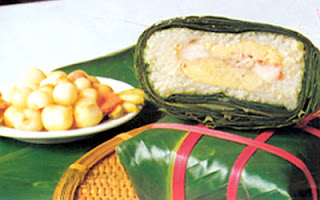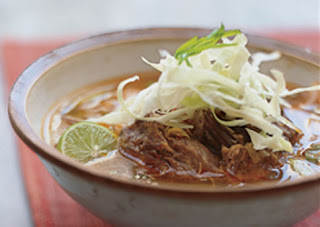Wednesday, April 13, 2011
"Banh Chung" - the soul of Vietnamese New Year
"Banh Chung" (Chung cake) is a traditional and irreplaceable cake of Vietnamese people in the Tet Holidays and King Hung’s anniversary (10th March Lunar). For the Vietnamese, making "Banh Chung" is the ideal way to express gratitude to their ancestors and homeland.
Banh Chung
The legend of " Banh Chung"
Chung cake was invented by the 18th Prince of Hung Emperor in the contest of looking for new Emperor. According to the legend, 3,000-4,000 years ago, Prince Lang Lieu, made round and square cakes, the round Day cake symbolizing the sky and the square Chung cake symbolizing the Earth (under the ancient Vietnamese perception), to be offered on the occasion of Spring.
In the ancient conception, the Earth is square, hence Chung cake's shape is square, too, to reflect the Earth shape. Since the cakes he offered were of special meaning and delicious taste, Lang Lieu was selected to be the next Emperor. Since then, in honor of this 18th Prince, Vietnamese people always make and have Chung cake in the Lunar New Year. Up to now, Chung cake has become the most famous and irreplaceable traditional Vietnamese food in Tet Holiday. This legend aims to remind the next generations of the ancient tradition as well as the primary of Chung cake. Besides, it emphasizes the important role of rice and nature in water rice culture.
How to make a "Banh Chung"?
In contrast to the fast food in modern life, the process of making Chung cake is time-consuming and requires the contribution of several people. Main ingredients are glutinous rice, pork meat, and green beans wrapped in a square of bamboo leaves that will give the rice a green color after boiling. The
sticky rice must be very good and was soaked in water in the previous day. Rice cake is wrapped in square shape, and the wrapping power must be neither tight nor loose. Then the cake will be boiled in about 12 hours by wood. The Green Chung cake has nutrition with an original tasty flavor and may be kept for a long time. Eating Chung cake with vegetable pickles will bring you unforgettable taste!
In the traditional conception of Vietnamese people, the process of making Chung cake is the opportunity for family to come together. Sitting around the warm fire, all members in the family tell one another the past stories and are ready for a New Year with wishes of best things. Nowadays, in some big cities, the business lifestyle of modern society prevent people from preparing the cake, however, the habit of worship ancestors with Chung cake never changes. It is the evidence of the Vietnamese loyalty and deep gratitude to ancestors.
Friday, April 1, 2011
Hue beef noodle – the typical culinary art of Hue!
In Hue city, the former citadel of Vietnam, it doesn't take you a lot of money to dine like a King!
Hue beef noodle takes its origin from the Royal Hue City of Central Vietnam. The broth is from cooking beef bones for a long period of time as well as a variety of different spices including lemongrass.
How does it taste? Well, having a bowl of Hue beef noodle, you will easily recognize that it is completely different from Pho since the former’s beef broth is much more spicy.
How to make it? Learning how to make a clear broth from bone and meat is quite a difficult task. After being selected from the market, the fresh beef will be shredded, boiled and taken out of the water to obtain a delicious clear broth. A typical version of Hue beef noodle must include pork, roast beef, pig’s blood, Vietnamese salami, Hue’s style salami, shrimp sauce and chopped lettuce.
The interesting thing is that, the amount of salt put in the beef noodle recipe varies between seasons. For example, during summer, Hue beef noodle soup is served with soy bean, mint and different kinds of lettuce while in the winter, the recipe is saltier added with lemongrass and fish.
The best Hue beef noodle comes from the street vendors who work from dawn to early morning. In Hue, when night lights are on, you can enjoy a good bowl of this noodle soup at restaurants in front of No. 84 Mai Thuc Loan Street. This hot dish represents just a few of the treasures of Hue's traditional cuisine. Clam-rice and the flour pies like beo (streamed flour cupcakes), nam (wrapped shrimp pies) and loc (tapioca and shrimp pies), for examples, are part of the ancient capital's culinary heritage.
Where to have Hue’s beef noodle in Ha Noi?
You are in Hanoi, and wondering if such a Hue’s specialty appears in Hanoi or not. Don’t worry, Hue beef noodle come up quite often in many streets of Hanoi from morning till night. It’s better to ask your hotel to recommend a place nearby or you can refer to the following reliable addresses:
• No. 4 Ly Thuong Kiet Street, Hanoi
• No.467 Đoi Can Street, Hanoi
• No.7 Thai Phien Street, Hanoi
• No.22 Phan Boi Chau Street, Hanoi
• No.175 Lang Ha Street, Hanoi
• No.G23 Huynh Thuc Khang Street, Hanoi
Subscribe to:
Posts (Atom)

